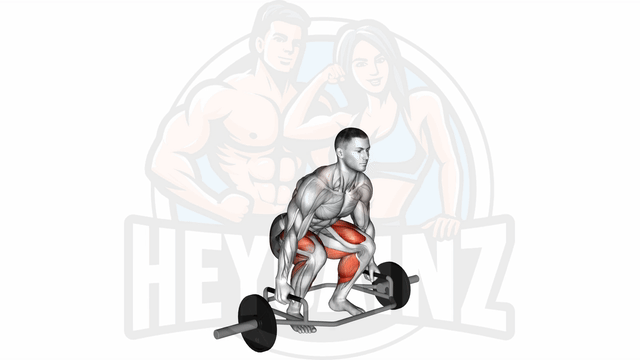
Instructions:
- 1Stand inside the trap bar with feet set hip-width apart
- 2Bend at your hips and knees to lower and grab the handles of the trap bar
- 3Stand up straight by using your legs to lift the weight
- 4Lower the weight carefully to the starting position
- 5Repeat the movement for the required number of repetitions
Tips:
- Keep your back straight throughout the exercise
- Wear appropriate footwear for stability
- Focus on pushing with your legs, not pulling with your back
- Ensure you maintain a consistent grip on the bar for the duration of the set
Trap-Bar Deadlift: A Comprehensive Guide
The trap-bar deadlift is an effective strength training exercise primarily targeting the thighs while engaging various muscle groups. This exercise utilizes a trap bar, also known as a hex bar, which allows for a unique grip and body position compared to traditional deadlifts. Whether you're a novice or an experienced lifter, incorporating the trap-bar deadlift into your routine can yield numerous benefits.
Muscles Worked
The trap-bar deadlift primarily activates the following muscles:
- Quadriceps
- Hamstrings
- Glutes
- Erector spinae
Additionally, it engages the upper back and trapezius, making it a well-rounded exercise for overall strength development.
Trap-Bar Deadlift Benefits
There are several advantages to integrating the trap-bar deadlift into your workout regimen:
- Reduced Injury Risk: The neutral grip and biomechanics can minimize strain on the lower back compared to conventional deadlifts.
- Enhanced Quad Activation: The design allows for a more upright position, enhancing quadriceps engagement.
- Improved Stability: The symmetrical positioning of the body can provide better balance and control during the lift.
Trap-Bar Deadlift Form
To perform the trap-bar deadlift correctly, follow these steps:
- Stand in the center of the trap bar with your feet shoulder-width apart.
- Bend at the hips and knees, gripping the handles securely.
- Keep your chest up and back straight, engaging your core.
- Push through your heels and extend your hips and knees simultaneously, lifting the barbell off the ground.
- Lower the trap bar by hinging at the hips and bending your knees, maintaining proper form until the weight is back on the floor.
It is crucial to focus on maintaining a neutral spine throughout the movement to avoid injury.
Trap-Bar Deadlift vs. Conventional Deadlift
Many individuals ponder the differences between the trap-bar deadlift and the conventional deadlift. While both exercises build strength and power, the trap-bar deadlift allows for a more natural lifting motion, reducing stress on the lower back and placing more emphasis on the quadriceps. This makes it an excellent alternative for those with back issues or those seeking to diversify their workout routine.
Weights and Progression
When starting with the trap-bar deadlift, it's essential to select a manageable weight that allows for proper technique. As strength builds, gradually increase the load to continue challenging your muscles. Monitoring your progress and listening to your body will help you optimize your performance safely.
Conclusion
The trap-bar deadlift is a powerful exercise for developing lower body strength while offering numerous benefits over conventional alternatives. Whether aiming to improve your athletic performance or simply seeking a new addition to your fitness routine, mastering the trap-bar deadlift can lead to impressive gains.